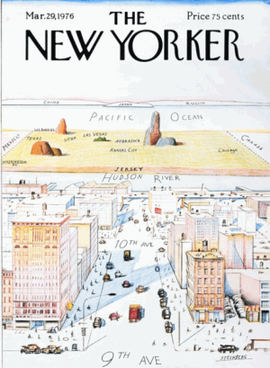This New Yorker cover, a 1976 illustration by Saul Steinberg that served as the cover of the March 29, 1976, edition of The New Yorker presents the view from Manhattan of the rest of the world showing Manhattan as the centre of the world.
Described as a tongue-in-cheek view of the world, National Post journalist Robert Fulford described the perspective as one in which the entire world is a suburb of Manhattan. It serves as an incredible reminder about our polarised view of our lives and the wider world beyond them.
The illustration is split in two parts, with the bottom half of the image showing Manhattan’s 9th Avenue, 10th Avenue, and the Hudson River (appropriately labelled), and the top half depicting the rest of the world. It is a westward view from 9th Avenue. Buildings along 9th Avenue are shown in detail, with those between 9th Avenue and the river also shown but in less detail; individual cars and trucks are drawn along the streets, and pedestrians are drawn along the sidewalks.
The rest of the United States is the size of the three New York City blocks and is drawn as a rectangle bounded by North American neighbours Canada and Mexico, with a thin brown strip along the Hudson representing “Jersey”, the names of five cities (Los Angeles; Washington, D.C.; Las Vegas; Kansas City; and Chicago) and three states (Texas, Utah, and Nebraska) scattered among a few rocks for the United States beyond New Jersey, which is in bolder font than the rest of the country beyond the Hudson. Washington, D.C. is depicted as a remote location near Mexico. The Pacific Ocean, slightly wider than the Hudson, separates the United States from three flattened land masses labelled China, Japan and Russia. The image depicts the world with a back turned to Europe, which is absent from the painting.
